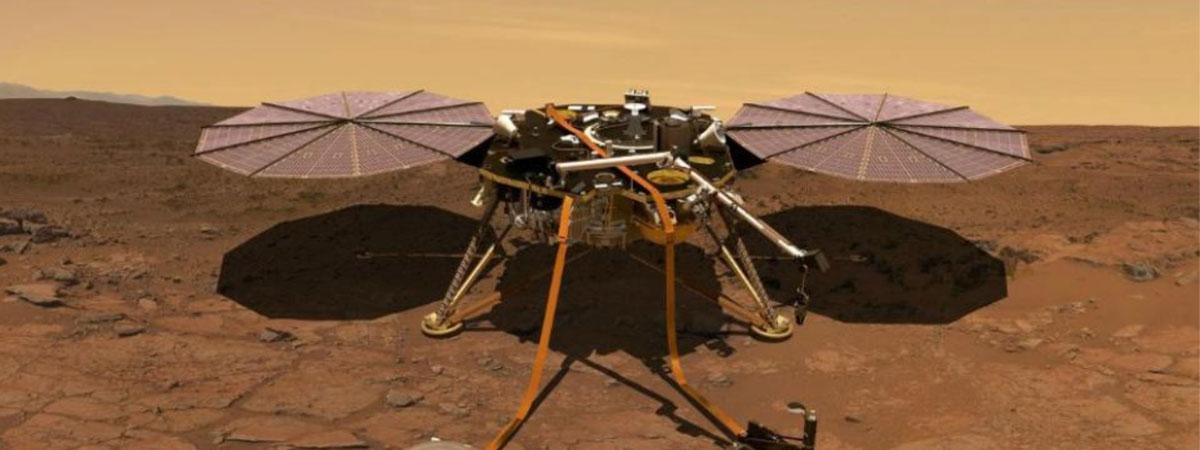World Watches as InSight Readies to Touch Down on Mars Tonight

Shortly after Monday midnight Indian time, the historic NASA spacecraft InSight will complete a nearly 485million kilometre journey to Mars, in its mission to give the red planet its very first comprehensive health checkup
Shortly after Monday midnight (Indian time), the historic NASA spacecraft InSight will complete a nearly 485-million kilometre journey to Mars, in its mission to give the red planet its very first comprehensive ‘health check-up’.
Insight, which was launched on May 5 this year, is scheduled to complete a nerve-wracking 7-minute entry into the red planet’s atmosphere and touch down gently on the surface at about 1.24 am IST. Scientists, astronomy enthusiasts and millions of people around the world are expected to watch the event live on NASA Television, the agency's website and social media platforms, including on YouTube.
The mission
'InSight' stands for Interior Exploration using Seismic Investigations, Geodesy and Heat Transport. If it succeeds, the spacecraft will become the first outer-space robotic explorer to study Mars' deep interior: its crust, mantle, and core. Scientists hope that the data will help us understand how rocky planets, like Mercury, Venus, Earth, and Mars, were formed, and also reveal details about Martian tectonic activity and past meteorite impacts.
When they formed around 4.5-4.6 billion years ago, both Earth and Mars exhibited many similarities. However, around 3-4 billion years ago, the two celestial neighbours took very different paths. Why did this happen? Scientists hope that over the next two years, InSight may provide us with the much-needed details to understand what produced an inhabitable Mars by exploring how the planet’s material is layered and how much heat comes out of it.
The landing
InSight will hit the top of the Martian atmosphere at a speed of 19,800 kmph and slow down to eight kph before its three legs touch down on Martian soil. That extreme deceleration has to happen in just under seven minutes. "There's a reason engineers call landing on Mars 'seven minutes of terror'," Rob Grover, InSight's entry, descent and landing (EDL) lead, based at NASA's Jet Propulsion Laboratory in Pasadena, California, said in a statement.
"We can't joystick the landing, so we have to rely on the commands we pre-programmed into the spacecraft. We've spent years testing our plans, learning from other Mars landings and studying all the conditions Mars can throw at us. We're going to stay vigilant till InSight settles into its home in the Elysium Planitia region," Grover said.
An experimental technology called Mars Cube One (MarCO) is being used in this mission to transmit the entry, descent and landing process— including hopefully, a photograph of the Mars surface right after InSight touches down on it. Besides MarCO, two other spacecraft will be used to relay data to Earth: the Mars Reconnaissance Orbiter (MRO), and the Mars Odyssey.
The ‘health check-up’
After landing, a robotic arm will place mission instruments—including a seismometer, a heat probe, and radio equipment—on the surface of Mars. Placing and calibrating the instruments will take 2-3 months. In the meantime, cameras on board will take colour, 3D images of the surroundings and equipment to be sent back home.
So what will the equipment do exactly? While the seismometer will use seismic waves to study the crust of Mars, the heat flow probe (HP3) will drill into the ground to sense the heat flowing out of Mars, and the Radio Science Experiment (RISE) will study how Mars moves in its orbit.
By checking Mars’ seismic ‘pulse’ and inner temperature, InSight will be mankind’s deepest look to date into the evolution of our closest planetary neighbour. In the process, we may learn a few things about ourselves and the universe we live in. And if that happens, it would more than justify the time and expense of the farthest house call made by a ‘doctor’ in human history.




















